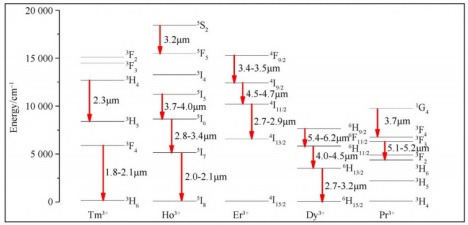2-5 μm mid-infrared laser crystals have important applications in directional infrared countermeasures, anti-terrorism, biomedicine, environmental monitoring, optical communications, strong field physics, laser fusion, and mid-to-far infrared (nonlinear frequency conversion) basic light sources, etc. With the related development of the pump source technology of semiconductor laser (laser diode, LD), solid-state laser and fiber laser (including resonant pump), mid-infrared crystal has become one of the four main laser crystals developed currently. In July 2012, Nature Photonics published a special issue “Mid-infrared Photonics”, regarding the 2-20 μm mid-to-far infrared laser as a new opportunity in the laser field.
Take the application of strong field physics as an example: the kinetic energy Eq of electrons oscillating in the light field determines the physical effect of the strong field and the state of the interaction between light and matter.
As shown in Formula (1), Eq is jointly determined by light intensity I and wavelength λ. At present, the peak power of near-infrared ultra-short and ultra-intense laser has reached the petawatt (PW, 1 PW=1015 W) level, the focused light intensity can reach 1021 W/cm2, and the Eq is as high as tens of MeV, making the interaction between light and matter enter into the “relativistic” region (electron speeds approaching the speed of light). In order to advance the interaction between light and matter to the “ultra-relativistic” region (the speed of protons is close to the speed of light), Eq needs to be greatly increased up to the GeV level. For this reason, researchers in many countries, especially European scientists, have planned ultra-high-power 100-petawatt Extreme Light Infrastructure (ELI). This is a trend in the development of ultra-short and ultra-intense lasers, which is characterized by moving toward a larger scale along the original near-infrared band intense laser technology route. However, due to the bottleneck limitations of core materials such as gratings and the key technology of pulse signal-to-noise ratio, these near-infrared hundred petawatt laser projects have not made substantial progress in the past ten years. Eq depends on Iλ2, so long wavelengths such as the mid-infrared band (2-5 μm) are a new dimension to obtain high oscillation kinetic energy Eq. The Joint Institute of Experimental Astrophysics at the University of Colorado, the Max Planck Institute of Quantum Optics in Germany, and Qian Liejia’s team at Shanghai Jiaotong University are developing mid-infrared high-power ultrafast laser systems.
According to the wavelength range, the main active ions and corresponding energy level transitions that can directly realize the output of 2-5 μm mid-infrared lasers are as follows (see Figure 1):
(1) ~ 2 μm: Tm3+, Ho3+
(2) ~ 2.3 μm: Tm3+
(3) 2~3 μm: Cr2+
(4) ~ 3 μm: Er3+, Ho3+, U4+, Dy3+
(5) ~ 4 μm: Fe2+, Ho3+
(6) > 4 μm: Dy3+, Er3+, Pr3+
Fig.1 Energy level diagram of rare-earth ions for mid-infrared laser output
Post time: Mar-29-2023


